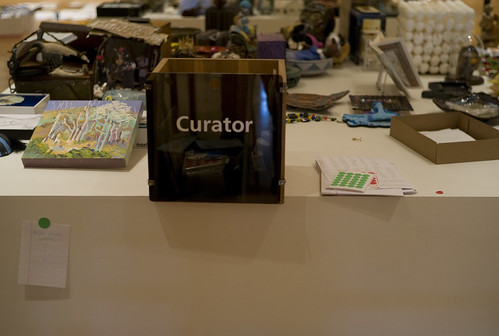 The frequency with which the words “curator” and “curating” pop up continues to rise. In art circles—where curators become “names” and international superstars, known as much for their packaging of ideas, talent, and trends as for the objects they pick to display—there’s a growing focus on curating as a practice unto itself. (This December, if you’re curious what the fuss is all about, ask Santa for über-curator Hans–Ulrich Obrist’s upcoming book, Everything You Always Wanted to Know about Curating But Were Afraid to Ask. Outside the art world, the title curator is increasingly being used to describe anyone who turns a critical eye toward the aggregation or highlighting of whatever content seems to be at hand. People curate news for their blogs and quirky pictures for their Tumblr accounts. Hipster merchandisers curate the content of pop-up stores. People curate cities, rose gardens, their closets, audiences, immune system data bases, and how they’ll represent their lives on social media sites like Facebook. “The word ‘curating’”—as one exasperated Tweeter quoted in a blog post called “Am I curating yet?” put it—“need some curation.”
The frequency with which the words “curator” and “curating” pop up continues to rise. In art circles—where curators become “names” and international superstars, known as much for their packaging of ideas, talent, and trends as for the objects they pick to display—there’s a growing focus on curating as a practice unto itself. (This December, if you’re curious what the fuss is all about, ask Santa for über-curator Hans–Ulrich Obrist’s upcoming book, Everything You Always Wanted to Know about Curating But Were Afraid to Ask. Outside the art world, the title curator is increasingly being used to describe anyone who turns a critical eye toward the aggregation or highlighting of whatever content seems to be at hand. People curate news for their blogs and quirky pictures for their Tumblr accounts. Hipster merchandisers curate the content of pop-up stores. People curate cities, rose gardens, their closets, audiences, immune system data bases, and how they’ll represent their lives on social media sites like Facebook. “The word ‘curating’”—as one exasperated Tweeter quoted in a blog post called “Am I curating yet?” put it—“need some curation.”  Last year, a reporter at the New York Times, feeling similarly, talked to linguists about the origins and current loose applications of the term. But then, more recently the newspaper got into the spirit, too, asking five well-known interior designers—including Kelley Wearstler, Jonathan Adler, and Vincete Wolf—to curate images from the paper’s vast photo-archives. Their selections—some inspired, some overly tasteful, some refreshingly wacky—were then printed up, matted, and framed, then offered for sale up to stylish readers with cash and wall space to spare. Among my favorites is one of Adler’s quirky picks, Going Groucho, 1974 which features two couples who’ve donned evening wear and gag glasses for reasons we may never know. But what this clever repurposing of archival images underscores are the roles archives can play in monetizing assets, keeping history alive and, yes, satisfying the curatorial fantasies so many of us seem to harbor.
Last year, a reporter at the New York Times, feeling similarly, talked to linguists about the origins and current loose applications of the term. But then, more recently the newspaper got into the spirit, too, asking five well-known interior designers—including Kelley Wearstler, Jonathan Adler, and Vincete Wolf—to curate images from the paper’s vast photo-archives. Their selections—some inspired, some overly tasteful, some refreshingly wacky—were then printed up, matted, and framed, then offered for sale up to stylish readers with cash and wall space to spare. Among my favorites is one of Adler’s quirky picks, Going Groucho, 1974 which features two couples who’ve donned evening wear and gag glasses for reasons we may never know. But what this clever repurposing of archival images underscores are the roles archives can play in monetizing assets, keeping history alive and, yes, satisfying the curatorial fantasies so many of us seem to harbor.
Produced by the Smithsonian Institution Archives. For copyright questions, please see the Terms of Use.

Leave a Comment